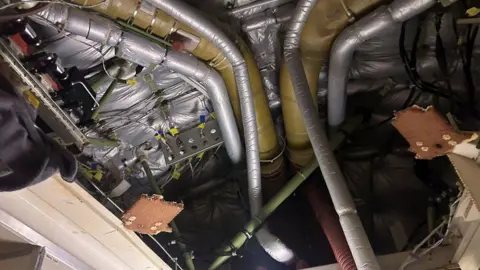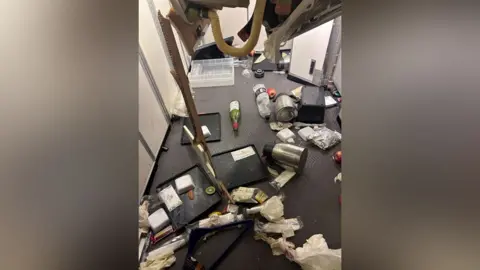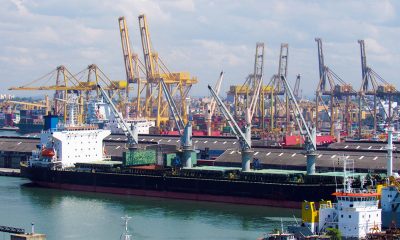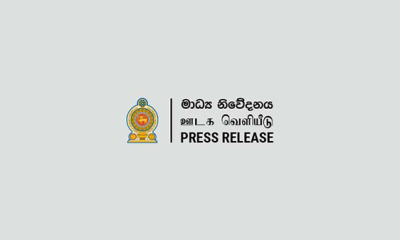Foreign News
Passengers recall horror onboard flight SQ 321

More than 140 travellers and crew members who were onboard a flight hit by severe turbulence landed in Singapore on a relief flight earlier this morning.
Passengers onboard SQ321 which was heading from London to Singapore, recounted scenes of “absolute terror”, with one passenger saying he saw a woman with an “awful gash on her head”, and heard another “screaming in agony”.
A 73-year-old British man, Geoff Kitchen, died from a suspected heart attack onboard, while several others remain seriously injured.
Mr Kitchen is believed to have suffered a heart attack when the plane was hit by the turbulence. Reports say he was on his way to Singapore to start a six-week holiday along with his wife who was also on board.
The Singapore-bound Boeing 777-300ER diverted to Bangkok following the mid-air incident, making an emergency landing at 15:45 local time (08:45 GMT) with some 211 passengers and 18 crew aboard.
Smitivej Hospital, in Bangkok, said 104 people were treated and 58 remain in hospital, 20 of whom are in the intensive care unit. There are 15 Britons still being treated in hospital, with six in intensive care, the hospital said.
Andrew Davies, a British passenger onboard the Boeing 777-300ER, told the BBC’s Radio that the plane “suddenly dropped with very little warning”. “The thing I remember the most is seeing objects and things flying through the air. I was covered in coffee. It was incredibly severe turbulence,” he said.
Another passenger said those not wearing seatbelts were “launched immediately into the ceiling”. “Very suddenly there was a very dramatic drop, so everyone seated and not wearing a seatbelt was launched immediately into the ceiling,” 28-year-old student Dzafran Azmir told Reuters. “I saw people from across the aisle just going completely horizontal, hitting the ceiling and landing back down in really awkward positions. People getting massive gashes in the head concussions.” Azmir added that people’s heads had slammed into the overhead panels above the seats and “pushed through” some of the panels.

Another Briton, Jerry, 68, was travelling to Australia for his son’s wedding. He said there was no warning before the “plane plunged”. “I hit my head on the ceiling, my wife did – some poor people who were walking around ended up doing somersaults,” he recalled. “My son was thrown down on the floor two rows behind me. I heard that there was a guy hitting the roof in the toilet and he was injured quite badly, too,” he said, speaking from a Thai hospital. He added that he and his family were “lucky enough” that none of them had died.
The family had been travelling to Australia for his son’s wedding on Friday, but now would not be able to make it, he said.
One Singaporean man, whose son was onboard the plane, said he was “thrown all over the place”. Chiew says his 22-year-old son was in London on holiday visiting his girlfriend, who was studying there on an exchange programme. The pair were flying back to Singapore when turbulence hit. He told the BBC: “My son was on his way to the restroom, while his girlfriend was seated. Both are okay. He said his son had messaged him yesterday afternoon to say he had landed in Bangkok after the flight was diverted.
An airline official said that about 10 hours into its flight, the plane had encountered “sudden extreme turbulence” over Myanmar’s Irrawaddy Basin at 37,000 feet.

Singapore Airlines also provided details on the nationalities of those on the flight, which included 56 people from Australia and 47 from the UK.
Allison Barker said she received a message from her son, Josh, who was on the plane en route to Bali: “I don’t want to scare you, but I’m on a crazy flight. The plane is making an emergency landing… I love you all.”
After that message, she waited for a “petrifying” two hours before hearing from him again. “One minute, he was just sitting down wearing a seatbelt, the next minute, he must have blacked out because he found himself on the floor with other people,” she told the BBC. Josh, she said, sustained minor injuries – but she is concerned that coming close to death could have a lasting impact on him.
The head of Singapore Airlines, Goh Choon Phong, apologised on Wednesday morning, saying the carrier was “very sorry for the traumatic experience”.
In a video statement, Mr Goh said the airline was “fully cooperating with relevant authorities on the investigations”. He also expressed his condolences to the family of the victim, adding that they would “render all possible assistance” to affected passengers and crew members.
Singapore Prime Minister Lawrence Wong also sent his “deepest condolences” to the family and loved ones of the deceased, adding that Singapore was “working closely with Thai authorities”.
He also said Singapore’s Transport Safety Investigation Bureau would conduct a thorough investigation into the incident.
Accidents involving Singapore Airlines are rare, with the carrier consistently ranking among the world’s safest.
The last fatal accident occurred in 2000, when a Boeing 747 crashed while attempting to take off from the wrong runway at a Taiwan airport.
Some 83 people of the 179 people onboard were killed.

Turbulence is most commonly caused by aircraft flying through cloud, but there is also “clear air” turbulence which is not visible on a jet’s weather radar.
“Injuries from severe turbulence are relatively rare in the context of millions of flights operated,” aviation expert John Strickland told the BBC.
Aviation journalist Sally Gethin said wearing a seatbelt could be the “difference between life and death”, explaining that anything not bolted down is at risk during severe turbulence.
Research has shown that climate change will make severe turbulence more likely in the future.
(BBC)
Foreign News
Nasa ‘Earthrise’ astronaut dies at 90 in plane crash

Apollo 8 astronaut Bill Anders, who snapped one of the most famous photographs taken in outer space, has died at the age of 90.
Officials say a small plane he was flying crashed into the water north of Seattle, Washington.
Anders’ son Greg confirmed that his father was flying the small plane, and that his body was recovered on Friday afternoon. “The family is devastated. He was a great pilot. He will be missed,” a statement from the family reads.
Anders – who was a lunar module pilot on the Apollo 8 mission – took the iconic Earthrise photograph, one of the most memorable and inspirational images of Earth from space.
Taken on Christmas Eve during the 1968 mission, the first crewed space flight to leave Earth and reach the Moon, the picture shows the planet rising above the horizon from the barren lunar surface.
Anders later described it as his most significant contribution to the space programme.

The image is widely credited with motivating the global environmental movement and leading to the creation of Earth Day, an annual event to promote activism and awareness of caring for the planet.
Speaking of the moment, Anders said: “We came all this way to explore the Moon, and the most important thing that we discovered was the Earth.”
Officials said on Friday that Anders crashed his plane around 11:40PDT (1940BST).
The US National Transportation Safety Board (NTSB) said the 90-year-old was flying a Beechcraft A A 45 – also known as a T-34. The agency said that the plane crashed about 80ft (25m) from the coast of Jones Island.
Anders also served as the backup pilot to the Apollo 11 mission, the name of the effort that led to the first Moon landing on July 24, 1969.
Following Anders’ retirement from the space programme in 1969, the former astronaut largely worked in the aerospace industry for several decades. He also served as US Ambassador to Norway for a year in the 1970s.
But he is best remembered for the Apollo 8 mission and the iconic photograph he took from space.
“In 1968, during Apollo 8, Bill Anders offered to humanity among the deepest of gifts an astronaut can give. He traveled to the threshold of the Moon and helped all of us see something else: ourselves,” Nasa Administrator Bill Nelson said in a statement.
Mark Kelly, a former astronaut who now serves as a US Senator for the state of Arizona, said in a post on X, formerly Twitter, that Anders “inspired me and generations of astronauts and explorers. My thoughts are with his family and friends”.
[BBC]
Foreign News
China’s Chang’e-6 lifts off from far side of Moon with rock samples

A Chinese spacecraft carrying rock and soil samples from the far side of the Moon has lifted off from the lunar surface to start its journey back to Earth, according to state media.
The achievement on Tuesday is a world first and the latest leap for Beijing’s decades-old space programme, which aims to send a crewed mission to the Moon by 2030.
The Xinhua News Agency, citing the China National Space Administration (CNSA), said that the ascender of the Chang’e-6 probe took off at 7:38am local time on Tuesday (23:38 GMT) and entered a preset orbit around the moon.
It described the move as “an unprecedented feat in human lunar exploration history”.
The Chang’e-6 probe was launched last month and its lander touched down on the far side of the Moon on Sunday. It used a drill and robotic arm to dig up soil on and below the Moon’s surface, according to Xinhua.
After successfully gathering its samples, the Chang’e-6 unfurled China’s national flag for the first time on the far side of the Moon, it said.
The agency cited the CNSA as saying that the spacecraft stowed the samples it had gathered in a container inside the ascender of the probe as planned.
[Aljazeera]
Foreign News
China says its spacecraft lands on Moon’s far side

China says its uncrewed craft has successfully landed on the far side of the Moon – an unexplored place almost no-one tries to go.
The Chang’e 6 touched down in the South Pole-Aitken Basin at 06:23 Beijing time on Sunday morning (22:23 GMT Saturday), the China National Space Administration (CNSA) said.
Launched on 3 May, the mission aims to collect precious rock and soil from this region for the first time in history. The probe could extract some of the Moon’s oldest rocks from a huge crater on its South Pole.
The landing was fraught with risks, because it is very difficult to communicate with spacecraft once they reach the far side of the Moon. China is the only country to have achieved the feat before, landing its Chang’e-4 in 2019.
After launching from Wenchang Space Launch Center, the Chang’e 6 spacecraft had been orbiting the Moon waiting to land. The lander component of the mission then separated from the orbiter to touch down on the side of the Moon that faces permanently away from Earth.
During the descent, an autonomous visual obstacle avoidance system was used to automatically detect obstacles, with a visible light camera selecting a comparatively safe landing area based on the brightness and darkness of the lunar surface, the CNSA was quoted as saying by state-run Xinhua news agency.
The lander hovered about 100m (328ft) above the safe landing area, and used a laser 3D scanner before a slow vertical descent. The operation was supported by the Queqiao-2 relay satellite, the CNSA said.
Chinese state media described the successful landing as an “historic moment”. The state broadcaster said “applause erupted at the Beijing Aerospace Flight Control Center” when the Chang’e landing craft touched down on the Moon early on Sunday morning.
The lander should spend up to three days gathering materials from the surface in an operation the CNSA said would involve “many engineering innovations, high risks and great difficulty”. “Everyone is very excited that we might get a look at these rocks no-one has ever seen before,” explains Professor John Pernet-Fisher, who specialises in lunar geology at the University of Manchester.
He has analysed other lunar rock brought back on the American Apollo mission and previous Chinese missions. But he says the chance to analyse rock from a completely different area of the Moon could answer fundamental questions about how planets form.
Most of the rocks collected so far are volcanic, similar to what we might find in Iceland or Hawaii. But the material on the far side would have a different chemistry . “It would help us answer those really big questions, like how are planets formed, why do crusts form, what is the origin of water in the solar system?” the professor says.
The mission aims to collect about 2kg (4.4lb) of material using a drill and mechanical arm, according to the CNSA.
The South Pole–Aitken basin, an impact crater, is one of the largest known in the solar system.
From there, the probe could gather material that came from deep inside the lunar mantle – the inner core of the Moon – Prof Pernet-Fisher says.
The Moon’s South Pole is the next frontier in lunar missions – countries are keen to understand the region because there is a good chance it has ice.

The capsule in the last Chinese moon mission, Chang’e 5, brought back soil and rocks in 2020 (BBC)
Access to water would significantly boost the chances of successfully establishing a human base on the Moon for scientific research.
If the mission succeeds, the craft will return to Earth with the precious samples on board a special return capsule.
The material will be kept in special conditions to try to keep it as pristine as possible.
Scientists in China will be given the first chance to analyse the rocks, and later researchers around the world will be able to apply for the opportunity too.
This is the second time China has launched a mission to collect samples from the Moon.
In 2020 Chang’e 5 brought back 1.7kg of material from an area called Oceanus Procellarum on the Moon’s near side.
China is planning three more uncrewed missions this decade as it looks for water on the Moon and investigates setting up a permanent base there.
Beijing’s broader strategy aims to see a Chinese astronaut walk on the moon by around 2030.
The US also aims to put astronauts back on the moon, with Nasa aiming to launch its Artemis 3 mission in 2026.
(BBC)
























